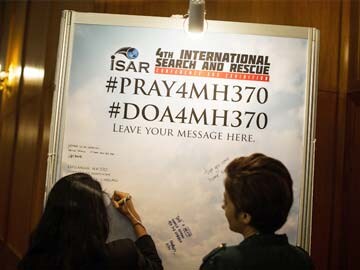
A visitor writes on a placard carrying messages for the passengers of missing Malaysia Airlines flight MH370.
Sydney:
The search for Malaysia Airlines Flight MH370 will move to a new area in the Indian Ocean, the Joint Agency Coordination Centre or JACC said on Wednesday.
The search team is responding to a series of electronic "handshakes" between the missing plane and a satellite operated by British company Inmarsat, the Xinhua news agency reported, citing JACC.
Satellite data suggests that the aircraft turned south across the Indian Ocean after flying near the Indonesian island of Sumatra.
This information remains the best lead that investigators have in trying to find the plane, said Angus Houston, the chief of the search operation.
"We are going to have to go deep and do a comprehensive look at the ocean floor," he said.
"The handshakes are the most robust information we have at the moment," Houston added.
The JACC said in a statement that the Australian-contracted survey vessel Fugro Equator has commenced operations in a defined search area. Chinese Navy's ship Zhu Kezhen is also undertaking survey activities.
"Under the direction of the Australian Transport Safety Bureau, the two vessels are conducting the bathymetric survey - or mapping of the sea floor - which is crucial to carrying out the deep water search for MH370 that is scheduled to commence in August," Houston said.
So far, the Zhu Kezhen has surveyed 4,088 square kilometres of the ocean floor.
It is anticipated that it will take at least three months to complete the bathymetric survey of the 60,000 sq.km search zone.
The ships will regularly send survey data to the ATSB and Geoscience Australia. This data will be used to progressively build a map of the search area.
The JACC said the search area will be confirmed before the end of June, after completion of extensive collaborative analysis by a range of specialists.
"It is already clear from the provisional results of that analysis that the search zone will move, but still be on the seventh arc (where the aircraft last communicated with satellite)," the JACC said.
The search team is responding to a series of electronic "handshakes" between the missing plane and a satellite operated by British company Inmarsat, the Xinhua news agency reported, citing JACC.
Satellite data suggests that the aircraft turned south across the Indian Ocean after flying near the Indonesian island of Sumatra.
This information remains the best lead that investigators have in trying to find the plane, said Angus Houston, the chief of the search operation.
"We are going to have to go deep and do a comprehensive look at the ocean floor," he said.
"The handshakes are the most robust information we have at the moment," Houston added.
The JACC said in a statement that the Australian-contracted survey vessel Fugro Equator has commenced operations in a defined search area. Chinese Navy's ship Zhu Kezhen is also undertaking survey activities.
"Under the direction of the Australian Transport Safety Bureau, the two vessels are conducting the bathymetric survey - or mapping of the sea floor - which is crucial to carrying out the deep water search for MH370 that is scheduled to commence in August," Houston said.
So far, the Zhu Kezhen has surveyed 4,088 square kilometres of the ocean floor.
It is anticipated that it will take at least three months to complete the bathymetric survey of the 60,000 sq.km search zone.
The ships will regularly send survey data to the ATSB and Geoscience Australia. This data will be used to progressively build a map of the search area.
The JACC said the search area will be confirmed before the end of June, after completion of extensive collaborative analysis by a range of specialists.
"It is already clear from the provisional results of that analysis that the search zone will move, but still be on the seventh arc (where the aircraft last communicated with satellite)," the JACC said.
Track Latest News Live on NDTV.com and get news updates from India and around the world

